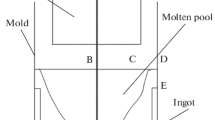Abstract
The VAR ingot has been the focus of several modelling efforts over the years with the result that the thermal regime in the ingot can be simulated quite realistically. Such models provide important insight into the solidification of the ingot but present some significant challenges to the casual user such as a process engineer. To provide the process engineer with a tool to assist in the development of a melt practice, a comprehensive model of the complete VAR process has been developed. A radiation heat transfer simulation of the arc has been combined with electrode and ingot models to develop a platform which accepts typical operating variables (voltage, current, and gap) together with process parameters (electrode size, crucible size, orientation, water flow, etc.) as input data. The output consists of heat flow distributions and solidification parameters. Utilizing heat balance information generated by the model, the effects of electrode-crucible orientation and arc gap have been explored with regard to the formation of ingot segregation defects.
Zusammenfassung
Der VAR-Blockherstellung steht seit Jahren im Mittelpunkt von mehreren Modellierungsansätzen mit dem Ergebnis, dass das thermische Regime im Block sehr realistisch simuliert werden kann. Solche Modelle liefern wichtige Einblicke in die Erstarrung der Blöcke, stellen aber einige bedeutende Herausforderungen an den Benutzer in der industriellen Praxis, wie zum Beispiel dem Prozessingenieur. Um dem Prozessingenieur ein Werkzeug zur Verfügung zu stellen, das ihn bei der Entwicklung seiner praktischen Erfahrung für das Schmelzen unterstützt, wurde ein umfassendes Modell des kompletten VAR-Prozesses entwickelt. Ein Simulationsmodel der Wärmübertragung durch Strahlung des Lichtbogens wurde mit Elektroden- und Block-Modellen kombiniert. Damit wurde eine Plattform entwickelt, die die typischen Betriebsgrößen (Spannung, Strom und Lichtbogenspalt) gemeinsam mit Prozessparametern (Elektrodengröße, Tiegelgröße, Ausrichtung, Wasserfluss, etc.) als Inputdaten übernimmt. Der Output besteht aus Wärmestromverteilungen und Erstarrungsparametern. Mit den Modellergebnissen aus der Wärmebilanzberechnung wurden die Auswirkungen der räumlichen Orientierung des Elektrodentiegels und des Lichtbogenspaltes im Hinblick auf die Bildung von Seigerungen im Block untersucht.
















Similar content being viewed by others
References
Ballantyne, A. S.: Simulation of Radiation Heat Transfer in a VAR Furnace Using an Electrical Resistance Network, Proc. of the 2013 Int. Symp. on Liquid Metal Processing and Casting, TMS, 2013, pp 253–260
Bertram, L. A.; Adasczik, C. B.; Evans, D. G.; Minisandram, R. S.; Sackinger, P. A.; Wegman, D. D.; Williamson, R. L.: Quantitative Simulations of Superalloy VAR Ingot at the Macroscale, Proc. Int. Symp. On Liquid Metal Processing and Castings, 1997, pp 110–132
Sucec, J.: Heat Transfer, New York: Simon & Schuster, 1975
Author information
Authors and Affiliations
Corresponding author
Rights and permissions
About this article
Cite this article
Ballantyne, A.S. The Development and Application of an Integrated VAR Process Model. Berg Huettenmaenn Monatsh 161 (Suppl 1), 12–19 (2016). https://doi.org/10.1007/s00501-016-0459-5
Received:
Accepted:
Published:
Issue Date:
DOI: https://doi.org/10.1007/s00501-016-0459-5



